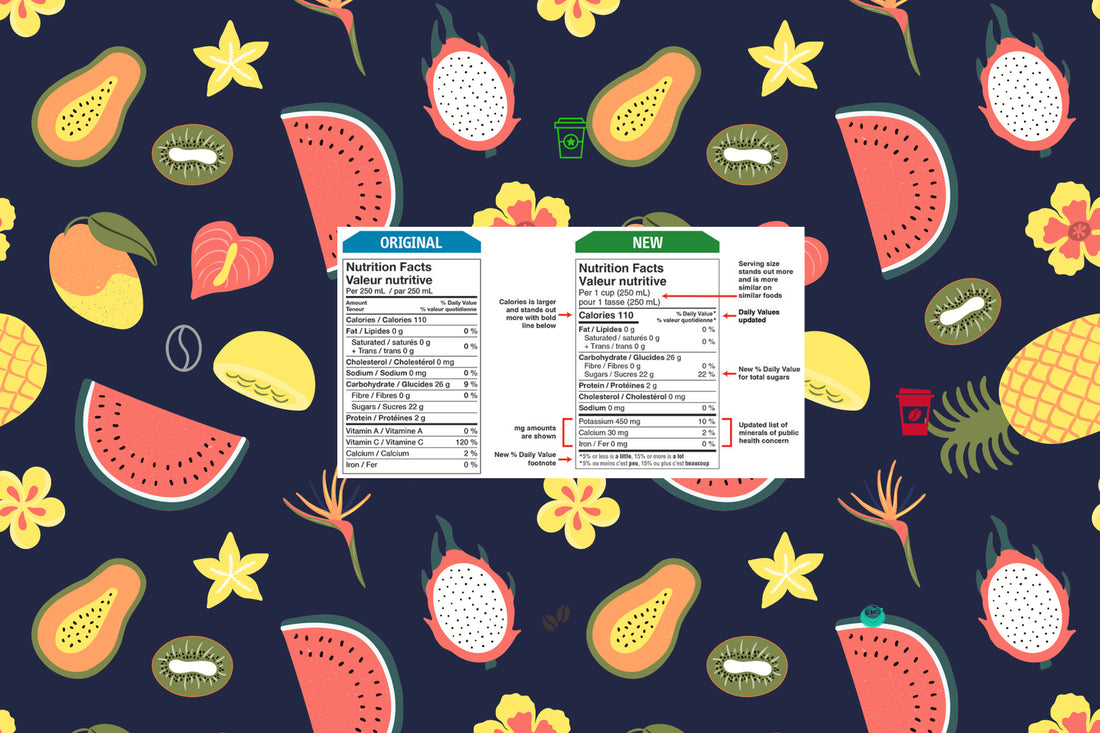Canadian Regulations Now Require a Nutrition Facts Table for Prepackaged Coffee
Created for the Canadian Barista Institute by:
MARTHA CARMANB.SC.(FOOD SCIENCE), M.SC.(BIOCHEMISTRY)
Carman Consulting Inc.
martha.carman@gmail.com
647.981.0295
linkedin.com/in/marthacarman
What are these regulatory changes?

- New regulations, “Amendments to the Food and Drug Regulations related to nutrition labelling, list of ingredients and food colours”, announced in late 2016, indicated that by end of 2021*, several changes are required to food labels.
- The “new” Nutrition Facts table (NFt) now includes:
- Mandatory declaration of Calories and 12 core nutrients
- “Potassium” was added as a core nutrient
- Vitamin A and Vitamin C are no longer “mandatory”
- Serving Size based on Health Canada’s Reference Amounts
- Graphical requirements of NFts:
- Black font on white background
- Size of the NFt on a label is based on Available Display Surface (ADS) of entire package
- Templates of NFts available in “Compendium of Nutrition Facts Tables” from federal government
*In late 2021, an extension was given. The Canadian Food Inspection Agency (CFIA) will focus its efforts on education and compliance promotion for the first year, until December 14, 2022.
As of December 15, 2022, CFIA will verify compliance and apply enforcement discretion in cases where non-compliant companies have detailed plans showing how they intend to meet the new requirements at the earliest possible time. COVID-19 Food labelling support measures - Canada.ca
Why are these regulatory changes necessary?
NFt - Nutrients and Daily Values (2016)
- The actual information shown in the NFt will be updated so that Canadians are better able to make food choices based on the most recent scientific knowledge.
- A number of adjustments have been made based on current recommendations from internationally recognized bodies such as the U.S. Institute of Medicine (IOM) and surveillance data from Canadian sources such as the Canadian Community Health Survey.
- Specifically, the list of nutrients that must be declared in the NFt (i.e. the core nutrients) has been revised to remove the requirement for the display of information on vitamins A and C, and to add a new requirement for the display of information on potassium.
- In addition, the Daily Values (DVs) for both core and non- core nutrients, have been updated to bring them in line with the latest dietary recommendations.
What is Potassium?
- Potassium is an essential mineral that is needed by all tissues in the body.
- It is sometimes referred to as an electrolyte because it carries a small electrical charge.
- Its main role in the body is to help maintain normal levels of fluid inside our cells. Sodium, its counterpart, maintains normal fluid levels outside of cells.
- Potassium supports:
- Normal blood pressure
- Nerve functioning
- Muscle contraction
- Transport of nutrients into cells and waste products out
- Diets low in potassium can lead to hypertension and hypokalemia.
- Why did the government change the regs.?
- Added potassium to NFt because:
- It’s important for maintaining healthy blood pressure & cardiovascular health
- Many Canadians exceed recommended sodium intake & risk having hypertension and cardiovascular disease
- Removed vitamin A and vitamin C from NFt because:
- Most Canadians get enough of these nutrients in their diets
Is potassium good for me?
Do you know that the % Daily Value for potassium is changing?
2016
- Daily Value for Potassium for Canadian adults is 4700 mg.
- Based on the National Academies of Sciences, Engineering and Medicine (NASEM), parent organization of former IOM, now called National Academy of Medicine (NAM), Dietary Reference Intakes (DRIs) for potassium, report of 2005.
2021*
- NASEM updated Dietary Reference Intakes (DRIs) for potassium, in 2019, decreasing DV for Potassium to 3400 mg.
- This means a cup of coffee would now provide 13 % DV for potassium.

Claims:
- Nutrient Content:
- “Source of Potassium” when amount of Potassium is > 235 mg per serving
- “High in Potassium” when amount of Potassium is > 470 mg per serving
- Disease Risk Reduction:
- Coffee does not meet conditions for this claim: "A healthy diet containing foods high in potassium and low in sodium may reduce the risk of high blood pressure, a risk factor for stroke and heart disease. (Naming the food) is high in potassium and is low in sodium."
What are the food sources of potassium?
- Relative to the top sources of potassium in our diet, coffee can be a “Source of Potassium”.
- When we consume more than 1 cup of coffee (250 mL) per day, each cup adds to our intake of potassium.

How much potassium is in coffee?

- Brewed coffee samples submitted to an accredited Canadian lab had approx. 3 to 4- fold potassium content of Canadian Nutrient File ; whereas, espresso had 57 % less.
- Potassium in brewed coffee was similar for regular and decaffeinated coffees.
- It’s important to have each type of coffee tested.
What if coffee isn’t consumed black?
- Some additions to coffee can increase its potassium content; however, with a 4300 mg/day Daily Value, these other food sources of potassium are not significant.

How much potassium is in your coffee?
There are many variables which could effect the amount of potassium in a specific cup of coffee!
- Type of bean (Arabica, Robusta) or blends
- Type of soil
- Geographic origin (Kenya, Brazil, Mexico)
- Horticultural practices
- Altitude
- Rainfall
- Fermentation
- Decaffeination (solvent, carbon dioxide gas)
- Roasting (facility, equipment, time, temperature, batch size, process control, moisture content)
- Grind
- Brewing (type, time, temperature, concentration, pressure)
- Water (hard or soft)
- Storage/ Shelf-life
Do I need to have a Nutrition Facts table on my label?
- Canadians need nutrition information to permit dietary management of chronic diseases of public health significance, and to help them make food choices that may reduce the risk of developing chronic diseases.
- The Food and Drug Regulations state that the Nutrition Facts table (NFt) is mandatory for most prepackaged foods and is required to be presented in a certain manner when it appears on a food label.
Do the amounts in my NFt have to be accurate?
Canadian Food and Drug Act and its Regulations
Subsection 5(1):
No person/ organization shall label, package, treat, process, sell or advertise any food in a manner that is false, misleading or deceptive or is likely to create an erroneous impression regarding its character, value, quantity, composition, merit or safety.
Subsection 5(2):
An article of food that is not labelled or packaged as required by, or is labelled or packaged contrary to, the regulations shall be deemed to be labelled or packaged contrary to subsection (1).
Did you know there are specific regulations for coffee?
Canadian Food and Drug Act and its Regulations – Coffee:
Coffee has a Compositional Standard / Standard of Identity in the Regs.

- Foods with prescribed standards must include only the stated ingredients within the prescribed limits.
- If the standard includes an ingredient to be used as a food additive, that additive must be used in accordance with the purpose and level provided by the SFCR or the FDR for that food.
Only these 3 solvents can be used to decaffeinate coffee beans

How do you determine the amounts of nutrients to declare in NFt?
- It is the manufacturer's responsibility to ensure that the nutrient values presented in the NFt are accurate.
- There are different ways to generate these values including calculation using credible databases & software or validated analytical methods by laboratories.
- Lab analysis, by an accredited laboratory, is generally the most accurate method of determining the nutritional profile of a given food; however, calculation may also be used if the manufacturer is confident that the results are accurate. The manufacturer must take into account various factors when choosing how to determine the nutrition values including the nature of the food, possible processing losses, seasonal variations, geographical variations, variable formulations, and so forth.
Did you know there are tolerances for the accuracy of Nutrient Amounts declared?
How much potassium is in your coffee?

Tolerances for Accuracy:
For potassium (and all other naturally occurring nutrients)
- The average of a future test of 12 individual units from the same lot:
- Minimum:
- Lab result must be > 80% of the label value e.g., Potassium > 360 mg
- Each sub-sample must be > 50% declared nutrient value e.g., Potassium > 225 mg
- Maximum:
- Lab result must be < 120% of the label value e.g., Potassium < 540 mg
- Each sub-sample must be < 150% declared nutrient value e.g., Potassium < 675 mg
Did you know there is a “special rule” for coffee & tea?
- The Serving Size for most foods is based on an “as sold” basis.
- However, for coffee (whole or ground beans and pods) and tea (dry loose leaves, bags and pods), the Serving Size is on an “as consumed” basis.
- This means coffee or tea must be brewed for lab analysis e.g., consumers drink coffee; they don’t eat the beans!
How much do lab nutritional analyses cost?
Considerations:
- Design of Sample Plan:# Lots and Samples per
- Protocol to prepare coffee for lab
- Caffeine analysis is not required. Would it be useful to know it for consumer inquiries?
- A strong sampling plan requires 12 samples (12 x $900 + tax); whereas working with a consultant, these costs can be reduced. e.g., 3 x $900 + tax
- A “combined” software + lab analyses approach may be appropriate for future labelling.
- U.S. and NFts from other countries are not permitted in Canada.

What if I already have printed packaging?
For example:
- There is no NFt on current package
- The current NFt printed on the label needs to be corrected
- Other changes to regs. need to be implemented on my labels:
Apply the “new” format to the List of Ingredients & Allergens/ Sensitivities
Apply “new” Serving Sizes
About Overstickering to correct labels:
- Acceptable “as long as sticker is permanent”
- If other aspects of label must also be added or corrected, it may diminish the aesthetics of the product

What other copy must be on the label?
- Bilingual language
- Canadian Spelling & Metric Units of Measure
- Product Name
- Common Name
- Net Quantity*
- Qualifier for vignette
- “Suggested serving”
- Claims (optional/ if applicable)
- Kosher / Halal
- Organic
- Fairtrade
- Artisanal
- “Roasted and blended in Canada”
- Romance copy
- Consumer Directions
- Recyclability of packaging
- Nutrition Facts table
- List of Ingredients & Allergens
- Durability Code
- Country of Origin
- Place of Business (same as Safe Food for Canadians License - SFCR)
- Barcode
Did you know?
- Most copy has very prescriptive regulations about its graphical representation (font height, font colour, location, etc.)
- The CFIA has jurisdiction over Canadian-based websites. Non- compliant websites may be subject to enforcement action.
Guess who hasn’t done their homework yet?


About Carman Consulting Inc.
References:
- Canada Gazette – Regulations Amending the Food and Drug Regulations (Nutrition Labelling, Other Labelling Provisions and Food Colours)
- https://medlineplus.gov/potassium.html
- https://www.canada.ca/en/health-canada/services/food-labelling-changes.html
- https://www.canada.ca/en/health-canada/services/food-nutrition/public-involvement-partnerships/notice-proposal-update-nutrition-labelling-table-daily-values.html
- https://food-nutrition.canada.ca/cnf-fce/newSearch-nouvelleRecherche.do?action=new_nouveau
- https://www.coffeeandhealth.org/topic-info/coffee-composition-nutrition-information
- https://www.mdpi.com/2304-8158/10/6/1328/htm
- https://www.canada.ca/en/health-canada/services/food-nutrition/food-labelling/nutrition-labelling/regulations-compliance/guide-developing-accurate-nutrient-values.html#a8
- https://inspection.canada.ca/food-labels/labelling/industry/nutrition-labelling/nutrition-facts-table/eng/1389198568400/1389198597278?chap=2
- https://inspection.canada.ca/food-label-requirements/labelling/industry/nutrition-labelling/nutrition-facts-table/eng/1389198568400/1389198597278?chap=1#s1c1










